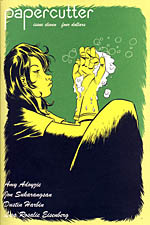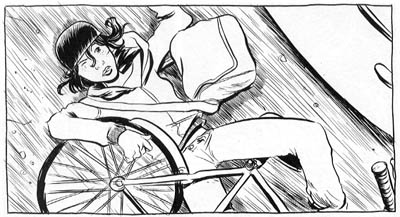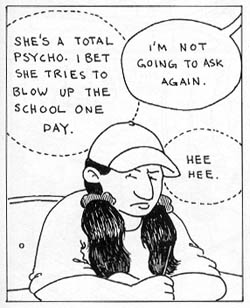 Written by Amy Adoyzie, Dustin Harbin, and Lisa Rosalie Eisenberg
Written by Amy Adoyzie, Dustin Harbin, and Lisa Rosalie Eisenberg
Art by Jon Sukarangsan, Dustin Harbin, and Lisa Rosalie Eisenberg
32 pages, black and white
Published by Tugboat Press
If I haven’t said it before, let me do so now. The best anthology series right now, in my book, is Papercutter from Tugboat Press. Published several times a year, each new issue contains several short stories from a wide range of comics talents, from up-and-coming creators to those who have already broken out and made a name for themselves. And while there are always some stories that work better than others, I do think it is safe to say that there’s never been a "dud" story. For an anthology that’s hit eleven issues, that’s a pretty amazing achievement.
Most of Papercutter #11 features a story by Amy Adoyzie and Jon Sukarangsan, "Lululand." What I like about Adoyzie’s script is that it is a perfect example of how to write a short story. It’s in many ways the final chapter of a novel you’ve never read; a lot has happened to Lulu up until this point, leading her to become a dishwasher in a diner. But the thing is, you don’t need to have read all the backstory. Everything you need to know is on the page; sometimes it’s unsaid but implied, but you don’t feel lost or confused.  While the genre of a post-college student trying to find themselves is familiar, Adoyzie brings a certain freshness to her script. It’s the early scene with Lulu and David where it clicked why; Lulu feels surprisingly real, as she asks questions and probes David about his own thoughts and feelings. She’s the kind of person that you probably already know, and it’s that outlook to the rest of the world around her that makes her—and the entire story—interesting. Sukarangsan’s art is a good match for Adoyzie’s script; the first four pages have no dialogue, but it’s easy to follow along to the inner workings of Lulu’s mind through her expressions and posture as she makes her way through the start of her day. "Lululand" may feel like I’ve gotten to read the final chapter of a novel (although in some ways it’s just as easily the beginning), but no matter where in Lulu’s life "Lululand" may fall, it made me want to somehow read more.
While the genre of a post-college student trying to find themselves is familiar, Adoyzie brings a certain freshness to her script. It’s the early scene with Lulu and David where it clicked why; Lulu feels surprisingly real, as she asks questions and probes David about his own thoughts and feelings. She’s the kind of person that you probably already know, and it’s that outlook to the rest of the world around her that makes her—and the entire story—interesting. Sukarangsan’s art is a good match for Adoyzie’s script; the first four pages have no dialogue, but it’s easy to follow along to the inner workings of Lulu’s mind through her expressions and posture as she makes her way through the start of her day. "Lululand" may feel like I’ve gotten to read the final chapter of a novel (although in some ways it’s just as easily the beginning), but no matter where in Lulu’s life "Lululand" may fall, it made me want to somehow read more.
The other two stories in Papercutter #11 are smaller, but still enjoyable. Dustin Harbin contributes a one-page "Duperman!" story that is an homage to the old Superman comics from back in the day. Like his counterpart, Duperman flies around the world, saving kittens and stopping robbers, but of course in his secret identity is at the bottom of the social totem pole. It’s nothing you haven’t seen before (and let’s face it, not that far off of what most people probably think of in terms of Superman comics), but Harbin brings charm to his story in his art. I love Duperman’s gigantic chin, and when Duperman’s boss starts berating him, that single panels with the boss stomping around just makes me laugh every time I look at it. The boss looks almost like a tiki figure, with arms raised up and legs in a strange stomping, dancing position. Even the little "stomp stomp" sound effects are perfect, and it’s amazing how such a simple little one-pager can still satisfy.
 Lisa Rosalie Eisenberg concludes the issue with "Letter Home," which both yearns to be a longer story and tells you everything you need to know about its protagonist Erin. Reading Eisenberg’s story brings to mind that student that is in every class, the one huddled in the back of the room that gets teased by the other kids and clearly has issues going on. As Erin lashes out at her teacher, it becomes rapidly clear who her anger is at, even without ever needing to state it. It’s a sad story, and one that may not have a happy ending for Erin any time in the near future. This sketch of her life seems simple, coming in at just five pages, but I was surprised at how much I found myself thinking about it afterwards. Eisenberg’s art certainly helps matters; it strangely reminded me of illustrations for a Judy Blume or Beverly Cleary book, and evoking those two authors is no small feat. It’s a simple style with a loose tangle of lines for texture and shading. I’m not sure this style would work well for other stories, but Eisenberg’s creation here comes together perfectly.
Lisa Rosalie Eisenberg concludes the issue with "Letter Home," which both yearns to be a longer story and tells you everything you need to know about its protagonist Erin. Reading Eisenberg’s story brings to mind that student that is in every class, the one huddled in the back of the room that gets teased by the other kids and clearly has issues going on. As Erin lashes out at her teacher, it becomes rapidly clear who her anger is at, even without ever needing to state it. It’s a sad story, and one that may not have a happy ending for Erin any time in the near future. This sketch of her life seems simple, coming in at just five pages, but I was surprised at how much I found myself thinking about it afterwards. Eisenberg’s art certainly helps matters; it strangely reminded me of illustrations for a Judy Blume or Beverly Cleary book, and evoking those two authors is no small feat. It’s a simple style with a loose tangle of lines for texture and shading. I’m not sure this style would work well for other stories, but Eisenberg’s creation here comes together perfectly.
Papercutter is one of those comics that keeps delivering the goods. There’s a strong line-up of creators with each issue, and I’m also always struck by the strong balance that Greg Brown brings to the book as an editor. Like with all past issues, when I’m done with the latest Papercutter I always start waiting and hoping for the next. If you haven’t checked this series out up until now, it’s a good a time as any to start.
